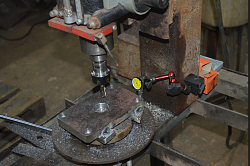I watched and enjoyed your video. I loved the way that you used the heavy angle iron and created a very solid ram. And I am guessing you are tired of welding that up!


I pay 0,3 USD per 1 Lb of steel on junkyard. In Polish conditions this is 2,5 higher price then in time when I started this project + 17,2% of inflation, things going to be fun. Luckily I bought all mechanical and electrical components on the begining of project so all I have to buy is just another 992Lb of steel to finish this project.
At $0.30, steel would be huge news here. Scrap rate is so high, it's virtually unobtainable, no matter what configuration of red iron, tubing, common bar stock, plate etc.
With less machinery being cast iron these days (and that advantage of natural dampening), you'll do well creating artificial filler that will accomplish that. Sand mixed with a little oil is a common material. Concrete type ballast shrinks, losing contact with vessel containing it, nullifying desired effect.
Building a machine of weldments is a super ambitious undertaking, I'll be following your posts, despite late joining the party. You'll get plenty of assistance from the entire HMT.net community.
Sincerely,
Toolmaker51
...we'll learn more by wandering than searching...
SteelCraft (Feb 20, 2023)
One thing about concrete. It doesn't shrink to much if it is properly mixed, and reinforcement rods internally keep it in place.
Second thing. Cast irons biggest plus is mass. It's structure is actually not as wonderful as we might imagine. A casting is a crystalized form of iron with as much carbon in it to lower the melting temperature as they determine is useful. Steel, a much lower carbon version of the same base metal can be just as god with your dampening methods mentions along with concrete dampening which is one of the easiest. Some place I have machine structural methods that use concrete inside nested tubes that make up very well behaved columns that are not crazy heavy.
Mark
SteelCraft (Feb 20, 2023)
Fully filled concrete likes tubular and straight forms better than tapers, such as in castings, per visual examinations. Additionally, slag, dirt and impurities don't enhance good 'bonding'; looking inside the few poured machines I know of, were not awe-inspiring. No clue what composition was used, care or curing provisions taken, so my impression is rather negative; they were all the same place. They could have shanghaied a hot mixer looking to dump for all I know.
According to patent descriptions, the 'ultimate' choice in cast iron is Meehanite ™? ®? . https://en.wikipedia.org/wiki/Meehanite
Occurs that very few machines and brochures display that tradename, as if licensing was exorbitant; either machinery builders have their own favorite concoction, or duplicated the patent just short of copy. My Bridgeport copy 'Comet' mill is so marked and rings dead as my 1917 Pratt & Whiitney jig bore. The P&W engineers were just as suspect as alchemists were, probably best until DeVlieg came along. The records for performance stability are somewhere in between them.
Lathes, having so many adjustable feet, don't count.
BTW; Monarch 10EE's? Only 3, talk about confidence.
Sincerely,
Toolmaker51
...we'll learn more by wandering than searching...
mwmkravchenko (Feb 20, 2023), SteelCraft (Feb 20, 2023)
Steel structure can be 2 times thiner than cast iron keeping the same rigidity. Of course, cast iron has better damping properties, but cast parts need to be seasoned for several years to stabilize the crystalline structure.
In my project I decided to keep a lot of mass despite the use of steel. If mass of steel won't damping enought then I will use concrete or sand.
Today I made bearing block for Y axis leadscrew. This set up is not very rigid but I'm impressed with surface finish I achieved.

mwmkravchenko (Feb 20, 2023), Toolmaker51 (Feb 20, 2023)
There are currently 1 users browsing this thread. (0 members and 1 guests)
Bookmarks